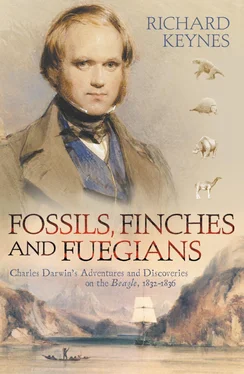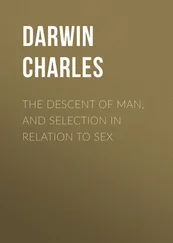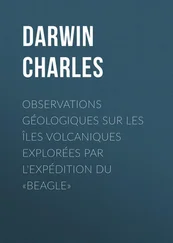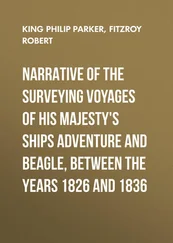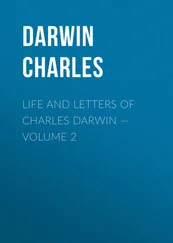A week later the Beagle sailed back to Bahia to find an explanation for the discrepancy of four miles in the meridian distance between the Abrolhos Islands and Rio de Janeiro shown in Baron Roussin’s chart as compared with the Beagle ’s measurements. In a private letter to FitzRoy, Beaufort later commended his ‘daring’ for thus having turned back without prior instruction from the Admiralty. 61 It turned out that Baron Roussin’s placing of the Abrolhos was correct, but not that of Rio, confirming that FitzRoy’s twenty-two chronometers and his dependence on a connected chain of meridian distances was the most reliable method of finding the precise longitude. This information was duly conveyed to the French commander-in-chief at Rio.
A less happy piece of news was that three members of a party who had sailed in the ship’s cutter to the river Macacu shortly before the Beagle ’s departure – an extraordinarily powerful seaman called Morgan, Boy Jones who had just been promised promotion, and Charles’s young friend Midshipman Musters – had been stricken with fatal attacks of malaria a few days later, and were buried at Bahia. FitzRoy considered that the danger of contracting the disease appeared to be greatest while sleeping, while Charles found it puzzling that the fever so often came on several days after the victim had returned to a seemingly pure atmosphere. The full details of the role of mosquitoes as the vector in the transmission of malaria were made clear by Sir Ronald Ross only in 1897.
For the next two months Charles assiduously explored Rio and the surrounding country, and on alternate days wrote up his notes and sorted out the specimens that he had collected, for he found that one hour’s collecting often kept him busy for the rest of the day. He noted that whereas ‘The naturalist in England enjoys in his walks a great advantage over others in frequently meeting something worthy of attention; here he suffers a pleasant nuisance in not being able to walk a hundred yards without being fairly tied to the spot by some new & wondrous creature.’ A discovery that particularly thrilled him was to find in the forest what was evidently a species of flatworm related to Cuvier’s Planaria, but which he thought was generally regarded as a strictly marine animal. He wrote:
June 17 th. This very extraordinary animal was found, under the bark of a decaying tree, in the forest at a considerable elevation. The place was quite dry & no water at all near. Body soft, parenchymatous, * covered with slime (like snails & leaving a track), not much flattened. When fully extended, 2 & ¼ inches long: in broardest parts only .13 wide. Back arched, top rather flat; beneath, a level crawling surface (precisely resembles a gasteropode [snail], only not separated from the body), with a slightly projecting membranous edge. Anterior end extremely extensible, pointed lengthened; posterior half of body broardest, tail bluntly pointed.
Colours: back with glossy black stripe; on each side of this a primrose white one edged externally with black; these stripes reach to extremities, & become uniformly narrower. sides & foot dirty “orpiment orange”. From the elegance of shape & great beauty of colours, the animal had a very striking appearance.
The anterior extremity of foot rather grooved or arched. On its edge is a regular row of round black dots (as in marine Planariæ) which are continued round the foot, but not regularly; foot thickly covered with very minute angular white marks or specks. On the foot in centre, about 1/3 of length from the tail, is an irregular circular white space, free from the specks. Extending through the whole width of this, is a transverse slit, sides straight parallel, extremities rounded, 1/60th of inch long, tolerably apparent (i.e. with my very weak lens). 62
The colours in inverted commas quoted by Charles in this and other descriptions of his specimens were taken from a neat little colour atlas by Patrick Syme in the Beagle ’s library, of which Charles made frequent use. The copy of this atlas that survived among his books at Down House in Kent is, however, spotless, so that the Beagle ’s hard-worked copy evidently had to be replaced after his return to England. In a letter to Henslow begun on 23 July 1832, Charles said: ‘Amongst the lower animals, nothing has so much interested me as finding 2 species of elegantly coloured true Planariæ, inhabiting the dry forest! The false relation they bear to snails is the most extraordinary thing of the kind I have ever seen. In the same genus (or more truly family) some of the marine species possess an organization so marvellous that I can scarcely credit my eyesight.’ 63 Henslow was unconvinced, and on page 5 of the edition of Charles’s letters to him printed for private distribution by the Cambridge Philosophical Society in 1835, the word ‘true’ was omitted, and ‘(?)’ was added after ‘Planariæ’. Charles’s observations on the anatomy and behaviour of these flatworms were nevertheless mainly correct, except that he thought they fed on decayed wood, whereas in fact they are carnivorous.
Charles was taken hunting one day by a wealthy priest who had a pack of five exotically-named dogs that were released into a forest of huge trees and left to pursue their own small deer and other game. In the intervals, the hunters with guns shot toucans and beautiful little green parrots in a rather aimless fashion. Charles was taken to see a bearded monkey shot the previous day, but did not record having seen a live one.
Once again he was disappointed in the Brazilian birds, which made surprisingly little show in their native country. One of the most characteristic sounds in Rio today is the repeated call of the tyrantflycatchers, but they do not possess the harmonious voice of the crotophaga, related to the parrots, of which Charles brought back a specimen with a stomachful of insects.
Better vocalists were found elsewhere, for in torrents of rain that soaked the fields he found a toad that sang through its nose at a high pitch, and then an equally musical frog:
On the back, a band of “yellowish brown” width of head, sides copper yellow; abdomen silvery yellowish white slightly tuberculated: beneath the mouth, smooth dark yellow; under sides of legs leaden flesh colour. Can adhere to perpendicular surface of glass. The fields resound with the noise which this little animal, as it sits on a blade of grass about an inch from the water, emits. The note is very musical. I at first thought it must be a bird. When several are together they chirp in harmony; each beginning a lower note than the other, & then continuing upon two (I think these notes are thirds to each other).
In addition to its ability to climb up a sheet of glass, the musician had some interesting parasites on its skin, and these too were preserved for identification.
A favourite excursion made by Charles several times with friends from the Beagle was to climb to the summit of the Corcovado mountain, a huge mass of naked granite looking down on Rio, where a century later the huge statue of Christ would be erected. On 30 May, Charles took his mountain barometer with him, and determined the height of the mountain to be 2225 feet above sea level, though possibly the figure of 2330 feet obtained on another occasion by Captain P.P. King was more reliable.
It was while he was in Rio that Charles wrote to Henslow: ‘I am at present red-hot with spiders, they are very interesting, & if I am not mistaken, I have already taken some new genera.’ He had indeed, and one of his captures was a crab spider of the family Thomisidae:
Evidently by its four front strong equal legs being much longer than posterior; by its habits on a leaf of a tree, is a Laterigrade: It differs however most singularly from that tribe & is I think a new genus. Eyes 10 in number, (!?) anterior ones red, situated on two curved longitudinal lines, thus the central triangular ones on an eminence: Machoires rounded inclined: languettes bluntly arrow shaped: Cheliceres powerful with large aperture for poison. Abdomen encrusted & with 5 conical peaks: Thorax with one small one: Crotchets to Tarsi, very strong (& with 2 small corresponding ones beneath?) Colour snow white, except tarsi & half of leg bright yellow. also tops of abdominal points & line of eyes black. It must I think be new. Lithetron paradoxicus Darwin!!! Taken in the forest. 65
Читать дальше
